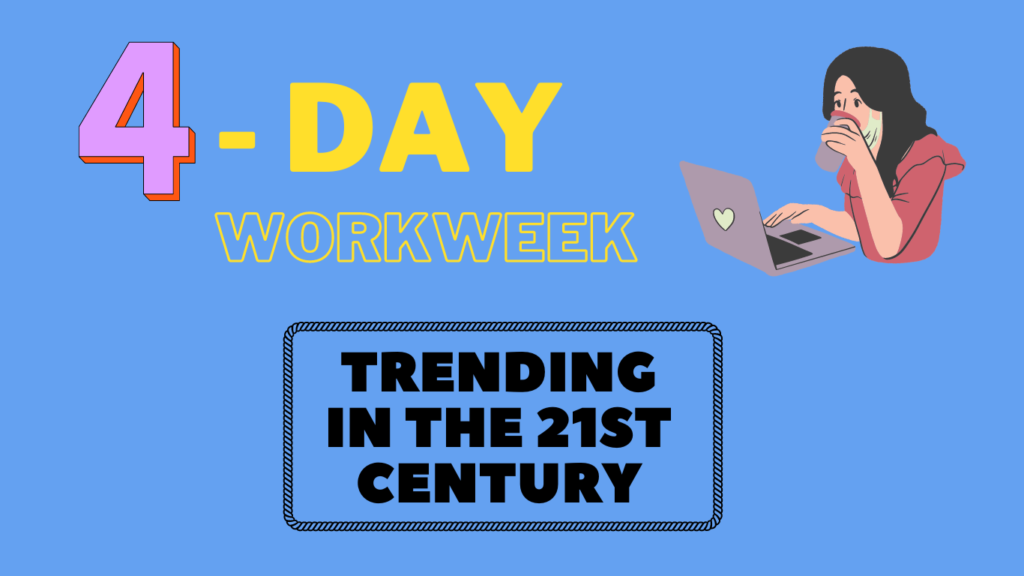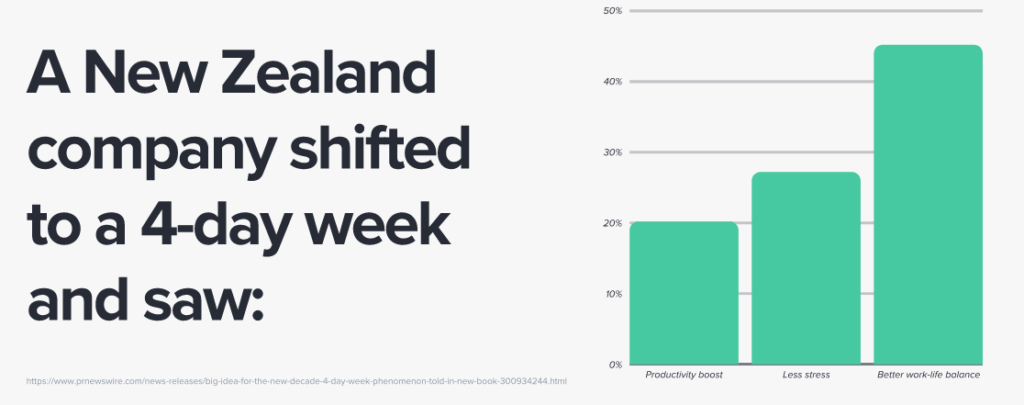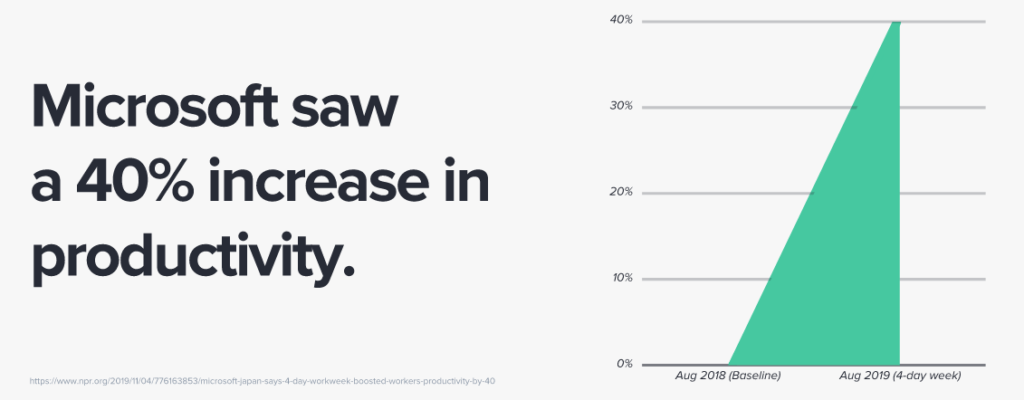The 4 Day Workweek Trending in the 21st Century

It’s fascinating to witness how the traditional 9-5 workweek is transforming into a routine more adapted to modern life, less rigid, and more approachable. It’s good that with advances in technology and changes in the way we live our lives, business owners and managers are looking for a new way to structure the work week.
In this line of thought, the 4-day workweek is becoming an increasingly popular option as more and more companies are seeing the benefits of this flexible schedule. In this blog post, we will explore the 4-day workweek and discuss why more businesses are turning to this model for increased productivity and efficiency! Let’s get started.

Behind the 4-Day Workweek
According to 4-day Week Global, a non-profit community that advocates for the 4-day workweek, “adopting a 4-day week is a business improvement strategy centered on working smarter rather than longer, and investing in the wellbeing of the most important asset to any business – your people. We advocate for the 100-80-100 model – 100% of the pay, 80% of the time, but critically in exchange for 100% of the productivity.“
So, the 4-day workweek is all about working smarter, not harder. And it’s not just a pipe dream – there are real companies out there that have made the switch to a 4-day workweek and are seeing amazing results!
For example, New Zealand-based Company Perpetual Guardian implemented a 4-day workweek for its 240 employees and found that not only was there no drop in productivity, but employee engagement and satisfaction increased!

“We’ve seen a 24% increase in engagement, a 20% reduction in sick days taken, and most importantly for us – staff are reporting better work/life balance,” said CEO Andrew Barnes, as confirmed by the graphic above.
The 4-day workweek is a schedule that compresses the traditional 40-hour workweek into 4 days instead of five. The compressed workweek usually involves working longer hours for 4 days and then taking the fifth day off
This is just a preview of why more companies are trying 4-day workweeks. Let’s broaden the data!
Why Implement a 4-day Workweek?
One of the most crucial reasoning behind this strategy is the premise that being at work translates into work being done, which is not necessarily true. According to the Bureau of Labor Statistics, the average American spends 8.8 hours at work daily; see the keyword? Spending time doesn’t really mean working, so the question is: For how long is an employee productive? Voucher Cloud says: the average UK office worker is only productive for 2 hours and 53 minutes out of the working day (ouch!).
So, of course, when we look at these numbers, it becomes imperative to find solutions, and the 4-day workweek seems like one. There are plenty of reasons to consider a 4-day workweek for your business. Let’s review them!
Productivity
The 4-day workweek is a popular productivity hack that can help you get more done in less time. The idea is simple: by working 4 days instead of 5, you reduce the amount of time you spend in the office and have more time to focus on your work. This can lead to increased productivity and efficiency.
Microsoft Japan tested a four-day workweek, and productivity jumped by 40%. The company gave employees five Fridays off in a row (without decreasing pay) and still saw a boost in productivity.

A 4-day workweek can also help avoid burnout. When you have more time outside work, you can focus on your well-being and recharge your batteries. This can lead to improved performance at work and increased productivity in the long run.
Flexibility
Embracing a 4-day workweek can also make your business more flexible. When you have fewer hours in the office, you can offer employees more flexibility regarding when they work and how they structure their day. This can lead to increased engagement and satisfaction.
It’s also worth noting that a 4-day workweek is not just about working fewer hours – it’s about working smarter. By being more strategic about how you use your time, you can get more done in 4 days than five.
Employee Satisfaction and Recruitment
While there are many benefits of a 4-day workweek, one of the most significant is its impact on employee satisfaction and recruitment. Employees who are satisfied with their jobs are more likely to stay with a company for longer.
Companies that offer this work schedule receive 15% more job applications and improve their capacity to retain top talent by 63%

In addition, satisfied employees can act as ambassadors for their company, making it easier to recruit new talent. Given the vital role that employee satisfaction plays in the success of a business, the 4-day workweek is an increasingly attractive option for businesses of all sizes.
Cost-Savings
Finally, a 4-day workweek can also lead to cost savings for your business. You can reduce your overhead costs when you have fewer hours in the office. This includes things like rent, utilities, and office supplies.
You can also save on employee costs by offering employees 4-day work weeks. This can help you attract and retain top talent while reducing payroll expenses.
Sustainability
A 4-day workweek may seem like a pipe dream for some, but it’s a very achievable goal that can significantly impact sustainability. The key is to think about work not in terms of hours but in terms of output.
Not only do employees seem to be just as productive, but they also report higher levels of satisfaction with their work-life balance.
Moreover, shorter workweeks can lead to lower carbon emissions since fewer people are commuting and there’s less need for office space.
In a world that is increasingly focused on sustainability, the 4-day workweek is an idea that is well worth exploring. It could be the key to achieving a better work-life balance for employees while also reducing our environmental impact.
Now that we know some of the reasons behind the 4-day workweek, let’s explore how it would work!
How Would a 4-Day Working Week Work?
Thinking about how a 4-day workweek would work can seem daunting, but it doesn’t have to be. There are a few different ways that businesses can make the transition.
Compressed Week
One option is to compress the work week into 4 longer days. For example, instead of working 8 hours a day, employees would work 10 or 12 hours 4 days a week. This can be beneficial because it allows employees to focus on work for a longer period of time and then have 3 days to relax.
This means some businesses choose to close their doors for one day each week

Staggering the Off Days
Another option is to stagger employees’ schedules so that there are always people in the office. This could involve having some employees start their day early, while others come in later and stay until later at night.
Or, another option is to stagger days off so that some employees have Friday off and others have Monday off, thereby ensuring that critical company functions are not compromised.
This doesn’t seem so difficult, does it?
Is the 4-Day Working Week For You?
So far, we have talked wonders about this business strategy, yet we don’t encourage seeing this solution through rose-colored glasses. Let’s take the example of Take Treehouse, an online education company based in Portland, Oregon.
In 2006, they switched to a 4-day workweek and found that employees were more productive and engaged when they had more time outside of work to pursue their interests and spend time with loved ones. However, for how long?

In 2015, the company decided to drop this schedule alleging it was damaging the company’s work ethic and culture. The 4-day workweek is not a one size fits all solution, which is something to keep in mind as you consider whether or not it’s right for your business.
This is a great reminder that the 4-day workweek isn’t always the perfect solution. There are pros and cons to this scheduling strategy, and it’s important to carefully consider both before making a decision.
Below, you have a set of some setbacks to consider:
Difficulty Coordinating between Employees on Different Schedules
One potential downside to a 4-day workweek is the difficulty coordinating between employees on different schedules. For example, if two employees have opposite 4-day schedules, they would only be able to see or communicate with each other for one day out of the week.
This could make it difficult to collaborate on projects or resolve conflicts. In addition, if an employee is out sick or on vacation, it may be more difficult for coworkers to pick up the slack since they are not in the office as often.
Loosely Defined Work Hours
One of the biggest problems with the 4-day workweek is that it can lead to loosely defined work hours. With fewer days in the office, employees may feel pressure to make up for the lost time by working longer hours on the days they are in the office. This can lead to longer hours and less downtime, which can eventually lead to burnout.
Loss of Business Due to Closed Doors One Day a Week
Another major downside is that businesses often lose revenue due to closed doors one day a week. This can be a particular problem for small businesses, which may not have the buffer of extra revenue to make up for the loss.
Additionally, customers may be less likely to return to a business that is closed more often, leading to even further loss of business. In addition, it could also lead to higher prices for goods and services, as businesses raise prices to offset the loss of revenue.
Increased Pressure to be Productive in a Shorter Time Frame
Then, we are pressured to be productive in a shorter time frame. Employees who have only four days to complete their work often feel pressured to accomplish more in less time.
This can lead to excessive stress and burnout. In addition, the 4-day workweek can create challenges for employers, who may have difficulty staffing their businesses during the shorter week.
But hey, don’t get discouraged! With the proper planning, approach, and execution, the 4-day workweek could run smoothly for you!
Best Approach to Implement the 4-Day Working Week
The 4-day workweek could be a great way to improve productivity and engagement in your workplace. However, it’s important to consider the potential downsides and take the best approach to implement this strategy.
Remember that the key to the 4-Day working week is to think about work not in terms of hours but in terms of the output
Some tips for implementing a 4-day workweek include:
- Defining clear expectations for employees
- Staggering days off so that not everyone is out of the office at the same time
- Encouraging employees to use their extra day off to recharge and disconnect from work
- Offering flexible hours or working from home options on the 4th day week
- Implement options for everyone to stay connected during the off day
Takeaway
Overall, the 4-day workweek is a trending topic in the 21st century. It’s important to explore the reasons behind it and how it would work before deciding if it’s right for your business.
So, is the 4-Day Workweek the next big thing?
Maybe! It’s a fact that more companies are trying out 4-day workweeks to increase productivity and decrease costs. This type of work schedule can also lead to sustainability.
If you’re thinking about making the switch to a 4-day workweek consider all the options, assess your company’s assets, and involve your employees in the transition! By following these tips, you can make sure that transitioning to a 4-day workweek goes smoothly for your business!
If you found this article helpful, take a look at our other blog posts on similar topics.
-The Monitask Team


